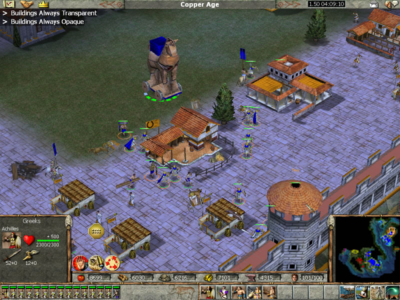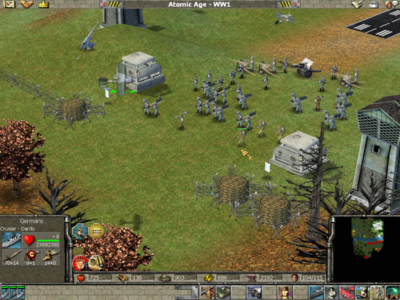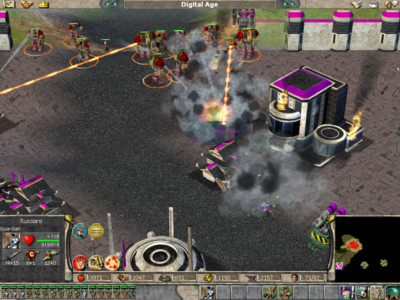
Empire Earth
Written by: Stoo
Date posted: November 11, 2006
- Genre: Strategy
- Developed by: Stainless Steel Studios
- Published by: Sierra Online
- Year released: 2001
- Our score: 7
To put this one in its proper context, we should first acknowledge Age of Empires, released in 1997. Whereas most realtime strategy games of the time used futuristic or fantasy settings, AoE was set in ancient history. Although a very conventional RTS in many regards – send little men to gather resources, build a base, churn out soldiers, attack enemy – it added a new feature of advancing in historical ages as a game progressed. For example, from bronze age to iron age. Each advance brought with it new, more powerful military units and so increased the strength of your entire army.
As is the way of successful a games, AoE spawned a sequel covering the middle ages. Then there came this one, Empire Earth. It isn’t an official sequel, but many of the former AoE developers were involved in its creation, so could be very much considered a close relative of the series. A single patch of the past wasn’t enough for them this time, however. In fact, they’ve gone and covered pretty much the entire course of human history, and then gone a few centuries into the future for good measure. A fairly ambitious move, then.
That means a total of fourteen ages. Want an overview? Of course you do: Your battles kick off in prehistoric times, your forces consisting of men waving clubs and throwing rocks. Your first advance, into the stone age, brings the first upgrades such as spearmen and slingers. From here you go through the copper and bronze ages, and a whole host of new units appear. Swordsmen, archers, boats, cavalry and the first siege engines. Then there’s the dark and middle ages, where you get, er, improved swordsmen and archers mostly. As the renaissance rolls in, however, the first gunpowder units show up. Growing in strength through the imperial age, cannon and riflemen are dominating the battlefield in the industrial age. The twentieth century is divided into three ages – first world war, second, and atomic age – and over the course of that we see the arrival of tanks and aircraft. Let’s not forget that ships like frigates and battleships have been getting their share of upgrades all this time, too. Finally we move into the digital age, then nano, the most important feature here of course being giant robots, hurray!
Putting their cynical hat on, a reader might ask, does all this progression in military hardware actually change much. Obviously a tank might do more hitpoints damage per attack than a guy with a sharp stick, but do the actual tactics change? Fortunately the answer is a pretty sure yes. Not every single advance means revolutionary changes, but there are many key unit types that change the course of battle when they arrive. Cavalry, cannon, tanks, robots, all take new tactics to both use and fight against effectively.
One feature to note is, this is one of those games that has a paper-scissors-stone style to battle. It’s often implemented through the different types of damage done by weapons (bashing, piercing etc) and a unit’s separate armour ratings against each of those As an example, in the early days the game hammers home the message: spearmen beat swordsmen, swordsmen beat archers, archers beat spearmen. In later ages you’ll have new versions of that balance to master. They don’t always make immediate sense – out at sea in the bronze age for example: battleship beats frigate (sounds about right), frigate beats galley (er, ok, they look pretty evenly matched to me), galley beats battleship (why?). Also pikemen seem to last longer than I might have expected from history – into the industrial age – to fill the”beats cavalry” slot.
Most of the time the balance is sensible enough though, and importantly the system means you have to use the right units to tackle a certain enemy. Take tanks for example. Even in large numbers they’re going to get chewed up by anti-tank guns, and aren’t equipped to fight back effectively. So building a huge swarm of single unit type and sending them ploughing into battle isn’t a route to success. A balanced force thus becomes necessary – those tanks need infantry support.
I mentioned the changing face of battle – what doesn’t change much is the base building and resource management. Be it the stone age or the nano age, you still gain iron and gold by sending out little men with pickaxes to bash away at a patch of ore. And that ore still pays for a barracks to churn out soldiers. Major advances between ages are fairly rare here. Walls for your base, but they appear in very early on anyway. Farms for steady food income, anti-aircraft guns. That’s about it.
In case you’re wondering about the graphics, the units are all done in true 3D. To make this possible with the technology of five years ago they had to be done with very low polygon counts. Which means infantry can look rather clunky and ugly up close. Then again as is usual for this kind of game, dramatic closeups of the action are rarely of any practical use. So you’ll be zoomed well out anyway. Keep your distance, and the game is, if rather plain, acceptable enough.
Anyway, I imagine lots of you will want to dive straight into a skirmish game, or multiplayer even. I’m not such a fan myself, although I have dutifully dabbled a little. I do know that it’s quite possible to advance through all the ages in a single game, provided you have several hours to spare. Each advance costs a lot of resources, however, so you have to balance the advantage gained, against forgoing building military units to pay for it. Advancing to the renaissance doesn’t count for so much, after all, if you’re up against twice your number of middle-ages troops.
Myself, I’m more a single player campaign kind of guy, and here there are in fact four. You rarely advance an age during a single mission, rather each campaign covers a couple of ages over the duration of eight or so missions. To begin: ancient Greece. Starting off with a primitive tribe seeking a new home, the campaign is based on historical (or legendary) events, such as the rise of Athens, the Trojan war and the rise of Alexander the great. The game makes a worthy attempt at providing a narrative throughout the campaigns, and lot of this is done with in-engine cutscenes Here we see with generals and leaders discussing their situation, addressing the troops etc. The voice acting isn’t the greatest, and Alexander doesn’t look so great when he’s too low-poly to even have actual feet, but at least they made an effort. The cutscenes do help bring events to life a little more, which gives extra incentive to play through the campaign.
Next campaign is all about medieval England and its long-running wars with France. Or at least it’s supposed to be, annoyingly two missions cover William the Conqueror at home before he even crossed the channel. Later on though some famous medieval battles are covered such as the Black Prince’s conquests, and the battle of Agincort. For those of you who feel gaming needs more Shakespeare, we’re treated along the way to a cutscene rendition of Henry V, with a such a hilariously clunky delivery I think they might have drafted some of the programmers to voice it themselves. Finally we scoot forward a few centuries for some clashes with Napeoleon.
Campaign three stars Germany in the twentieth century. The first world war doesn’t feature trenches, but you do get to see ranks of soldiers cut down with machine guns and artillery shells. As for the second world war, the N-word is studiously avoided at all times, but you’re still sending troops to blitzkrieg Poland. You might also note, it’s only around the end of this campaign that the game starts to get genuinely challenging. Or at least it did for me, I suspect more skilled players wouldn’t break into much of a sweat.
For a finale, then a speculative look at Russia over the next few centuries, and its attempt to conquer pretty much the entire planet. Here of course are the trickiest missions, especially as the game occasionally likes to put you in the unfair position of being an age or two behind the enemy.
With so many nations represented in the game, you might wonder if there’s any practical difference between them. They don’t get a different unit selection – instead there are a couple of methods of customizing an army. Unit types can be upgraded in-game in a Warcraft style for greater armour, weapon damage, speed and hitpoints, in exchange for resources. There’s also a separate list of upgrades that can be chosen from a list, based around either improved resource-gathering, or boosts to general unit types (like tanks or spearmen). In a skirmish game you choose from a few set lists of upgrades. In the campaign however you earn points as missions progress, which can be spent on upgrades one at a time. It’s a neat feature that can help shape your forces and tactics towards your preferred style, or compensate for a weakness somewhere. Just don’t do something stupid like buying robot upgrades in ancient Greece.
Overall Empire Earth does pretty well within the goals it sets itself. At heart it’s just another RTS, to be sure, lacking the advanced features or realism we might expect from the likes of Total War. Still it provides some pretty exciting and fast-paced battles in proper RTS style. Cavalry charges on legions of swordsmen, fighter-bombers shooting up tanks, or giant robots causing havoc, it offers them all and does a good job each time. So unless you’re demanding the greatest graphics in a strategy game – in which case why are you reading this in the first place – this comes with high recommendations from myself.





 Posts
Posts
[…] wanting a more modern setting. And yeah, there WAS Empire Earth, which you can read about over on A Force For Good, but that effort felt a bit clunky and overly ambitious. Finally, in 2001, strategy honks would […]
December 6, 2020 @ 8:10 am